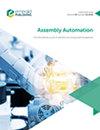Multi-objective worker allocation optimisation in a multiple U-line system
IF 1.7
4区 计算机科学
Q3 AUTOMATION & CONTROL SYSTEMS
引用次数: 1
Abstract
Purpose This paper aims to evaluate two operational modes of the worker allocation problem (WAP) in the multiple U-line system (MULS). Five objectives are optimised simultaneously for the most complicated operational modes, i.e. machine-dominant working and fixed-station walking. Besides, the benefits of using multiline workstations (MLWs) are investigated. Design/methodology/approach The elite non-dominated sorting differential evolutionary III (ENSDE III) algorithm is developed as a solution technique. Also, the largest remaining available time heuristic is proposed as a baseline in determining the number and utilisation of workers when the use of MLWs is not allowed. Findings ENSDE III outperforms the cutting-edged multi-objective evolutionary algorithms, i.e. multi-objective evolutionary algorithm based on decomposition and non-dominated sorting differential evolutionary III, under two key Pareto metrics, i.e. generational distance and inverted generational distance, regardless of the problem size. The best-found number of workers from ENSDE III is substantially lower than the upper bound. The MULS with MLWs requires fewer workers than the one without. Research limitations/implications Although this research has extended several issues in the basic model of multiple U-line systems, some assumptions were used to facilitate mathematical computation as follows. The U-line system in this research assumed that all lines were produced only a single product. Besides, all workers were well-trained to gain the same skill. These assumptions could be extended in the future. Practical implications The implication of this research is the benefits of multiline workstations (MLWs) used in the multiple U-line system. Instead of leaving each individual line to operate independently, all lines should be working in parallel through the use of MLWs to gain benefits in terms of worker reduction, balancing worker’s workload, higher system utilisation. Originality/value This research is the first to address the WAP in the MULS with machine-dominant working and fixed-station walking modes. Worker’s fatigue due to standing and walking while working is incorporated into the model. The novel ENSDE III algorithm is developed to optimise the multi-objective WAP in a Pareto sense. The benefits of exploiting MLWs are also illustrated.多U-line系统中的多目标工人分配优化
目的研究多u线系统(MULS)中工人分配问题(WAP)的两种运行模式。对于最复杂的操作模式,即机器主导工作和固定站行走,同时优化了五个目标。此外,还研究了使用多线工作站(mlw)的好处。设计/方法/途径精英非支配排序差分进化III (ENSDE III)算法是一种求解技术。此外,在不允许使用mlw时,建议将最大剩余可用时间启发式作为确定工人数量和利用率的基线。发现无论问题大小如何,在代距和倒代距两个关键Pareto指标下,sensde III都优于前沿的多目标进化算法(即基于分解和非支配排序的多目标进化算法)。从ENSDE III找到的最佳工人数量大大低于上限。有mlw的MULS比没有mlw的MULS需要更少的工人。虽然本研究扩展了多u线系统基本模型中的几个问题,但为了便于数学计算,本研究使用了一些假设。本研究中的u线系统假设所有生产线只生产一种产品。此外,所有的工人都受过良好的培训,以获得相同的技能。这些假设在未来可能会得到扩展。实际意义本研究的意义是在多u线系统中使用多线工作站(mlw)的好处。与其让每条生产线独立运行,不如让所有生产线通过mlw并行运行,从而在减少工人数量、平衡工人工作量和提高系统利用率方面获得好处。原创性/价值本研究首次探讨了机器主导工作和固定站行走模式下MULS的WAP问题。工人在工作时因站立和行走而产生的疲劳被纳入模型。为了在Pareto意义下优化多目标WAP,提出了一种新的endesiii算法。还说明了利用mlw的好处。
本文章由计算机程序翻译,如有差异,请以英文原文为准。
求助全文
约1分钟内获得全文
求助全文
来源期刊

Assembly Automation
工程技术-工程:制造
CiteScore
4.30
自引率
14.30%
发文量
51
审稿时长
3.3 months
期刊介绍:
Assembly Automation publishes peer reviewed research articles, technology reviews and specially commissioned case studies. Each issue includes high quality content covering all aspects of assembly technology and automation, and reflecting the most interesting and strategically important research and development activities from around the world. Because of this, readers can stay at the very forefront of industry developments.
All research articles undergo rigorous double-blind peer review, and the journal’s policy of not publishing work that has only been tested in simulation means that only the very best and most practical research articles are included. This ensures that the material that is published has real relevance and value for commercial manufacturing and research organizations.
 求助内容:
求助内容: 应助结果提醒方式:
应助结果提醒方式:


